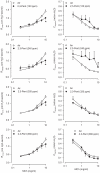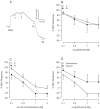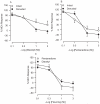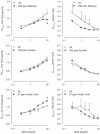Popcorn flavoring effects on reactivity of rat airways in vivo and in vitro
- PMID: 23941636
- PMCID: PMC4499850
- DOI: 10.1080/15287394.2013.796302
Popcorn flavoring effects on reactivity of rat airways in vivo and in vitro
Abstract
"Popcorn workers' lung" is an obstructive pulmonary disease produced by inhalation of volatile artificial butter flavorings. In rats, inhalation of diacetyl, a major component of butter flavoring, and inhalation of a diacetyl substitute, 2,3-pentanedione, produce similar damage to airway epithelium. The effects of diacetyl and 2,3-pentanedione and mixtures of diacetyl, acetic acid, and acetoin, all components of butter flavoring, on pulmonary function and airway reactivity to methacholine (MCh) were investigated. Lung resistance (RL) and dynamic compliance (Cdyn) were negligibly changed 18 h after a 6-h inhalation exposure to diacetyl or 2,3-pentanedione (100-360 ppm). Reactivity to MCh was not markedly changed after diacetyl, but was modestly decreased after 2,3-pentanedione inhalation. Inhaled diacetyl exerted essentially no effect on reactivity to mucosally applied MCh, but 2,3-pentanedione (320 and 360 ppm) increased reactivity to MCh in the isolated, perfused trachea preparation (IPT). In IPT, diacetyl and 2,3-pentanedione (≥3 mM) applied to the serosal and mucosal surfaces of intact and epithelium-denuded tracheas initiated transient contractions followed by relaxations. Inhaled acetoin (150 ppm) exerted no effect on pulmonary function and airway reactivity in vivo; acetic acid (27 ppm) produced hyperreactivity to MCh; and exposure to diacetyl + acetoin + acetic acid (250 + 150 + 27 ppm) led to a diacetyl-like reduction in reactivity. Data suggest that the effects of 2,3-pentanedione on airway reactivity are greater than those of diacetyl, and that flavorings are airway smooth muscle relaxants and constrictors, thus indicating a complex mechanism.
Figures












References
-
- Aarhus LL, Rimele TJ, Vanhoutte PM. Removal of epithelium causes bronchial supersensitivity to acetylcholine and 5-hydroxytryptamine. Fed. Proc. 1984;43:995.
-
- Borders CL, Jr., Riordan JF. An essential arginyl residue at the nucleotide binding site of creatine kinase. Biochemistry. 1975;14:4699–4704. - PubMed
-
- Boylstein R, Piacitelli C, Grote A, Kanwal R, Kullman G, Kreiss K. Diacetyl emissions and airborne dust from butter flavorings used in microwave popcorn production. J. Occup. Environ. Hyg. 2006;3:530–535. - PubMed
-
- Cavalcanti Zdo R, Albuquerque Filho AP, Pereira CA, Coletta EN. Bronchiolitis associated with exposure to artificial butter flavoring in workers at a cookie factory in Brazil. J. Bras. Pneumol. 2012;38:395–399. - PubMed
MeSH terms
Substances
Grants and funding
LinkOut - more resources
Full Text Sources
Other Literature Sources
